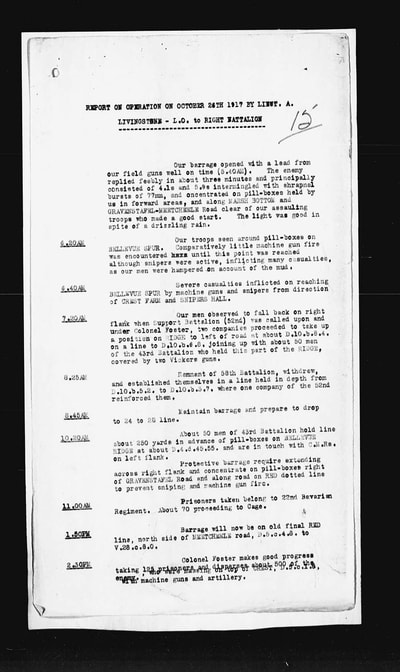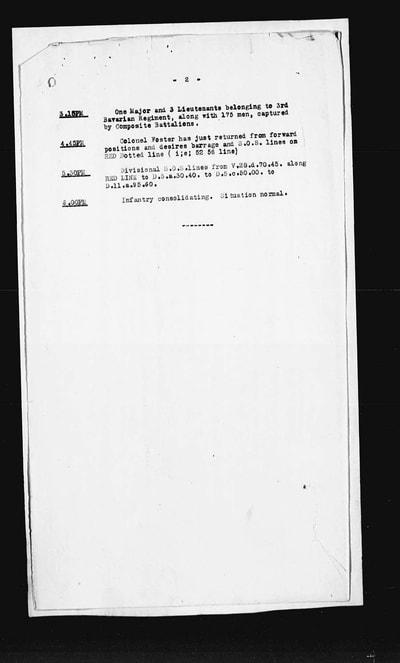|
One hundred years ago on 26 October 1917
31st Battery, Canadian Field Artillery, Canadian Expeditionary Force was a sub-unit of the 9th Canadian Field Artillery Brigade in the 3rd Canadian Division. The 9th Brigade war diary records: It rained very heavily during the night and was raining when the attack on PASSCHENDAELE started at 5.40 am. The enemy artillery opened up one minute after our Zero Hour and during the morning his artillery fire was very heavy. Owing to the flooded and impassable state of the ground our attacking infantry found it almost impossible to move and their machine guns became clogged with mud. Very heavy machine gun fire was encountered from enemy pill-boxes and as our men could not move with rapidity to outflank these, heavy casualties were sustained, and the attack was held up about the middle objective. In the afternoon by continuous hand to hand fighting we established a strong line which included a row of pill-boxes on BELLEVUE HEIGHTS and the enemy have been unable to dislodge us from this line. Owing to the rain and poor visibility there was no aerial work done. Special reports are attached from this brigade and from Lieuts. Manning and Livingstone, Brigade F.O.O. and Battalion Liaison Officer, respectively. 3rd Canadian Divisional Artillery war diary records: At 5.40.a.m. the 8th and 9th. Brigades, 3rd. Canadian Division in conjunction with the 1st. Anzacs on the right and the 5th. Army on the left attacked. This being the first of three attacks to gain PASSCHENDAELE and the high ground in the vicinity. Our barrage commenced well together and on time. The weather conditions were bad, considerable rain falling during the day interfering with observation and aerial activity. BELLEVUE HEIGHTS and approximately all objectives were gained and hold. Hostile planes dropped bombs in the vicinity of YPRES and Wagon Lines during the night. 8th Army Brigade, CFA. Is attached to 3rd. C.D.A. O.O.145 No. of guns in action – 121 – 18-pdrs. 45 – 4.5” Hows. Ammunition expended A.2176, AX.13432, A.smoke, 410, BX.5213, BCBR.300, BS.190. 5th Canadian Siege Battery, Canadian Artillery, Canadian Expeditionary Force was a sub-unit of 1st Canadian Heavy Artillery Group. Their war diary records: Got guns into action for the advance of today but gun went out of action before the end of the day and had to be pulled out and put back on new line. Fired 298 Rounds attack barrage and 31 Rounds protective barrage on Battery lanes. During the evening we fired 12 Rounds, bursts of Fire and during the dark hours fired 50 Rounds on Valour Farm. 1st Canadian Heavy Artillery Group war diary records: Barrages, bursts of fire and concentrations carried out intermittently 1004 rounds all calibers being expended during the day. General Officer Commanding, Royal Artillery, Canadian Corps war diary records: At 05:40 the 3rd and 4th Canadian Divisions attacked on a front of 2700 yds. in conjunction with operations by 18th Corps on the left and 1st ANZACS on the right. In conjunction with this operation, siege groups placed barrage in accordance with plan; concentrated and harrassing fire covering all main enemy approaches, assembly areas and centers of activity. Counter-btys. engaged 40 hostile btys. during the operation. Intense concentration was placed on MOORSLEDE, and harrassing fire was continued throughout the day. All field art'y fired barrages, and later protecting and harrassing fire. Hostile art'y at time of attack barrage was heavy but scattered; later on fire became directed on newly won positions but was also erratic. 15th Field Artillery Regiment RCA perpetuates the following sub units: 31st Battery, Canadian Field Artillery, Canadian Expeditionary Force, 5th Canadian Siege Battery, Canadian Artillery, Canadian Expeditionary Force, 68th Battery, Canadian Field Artillery, North Russia Expeditionary Force, was not authorized to be formed until 3 August 1918, and 85th Battery, Canadian Siberian Expeditionary Force was not authorized to be formed until 12 July 1918. |
Archives
June 2024
|





 RSS Feed
RSS Feed